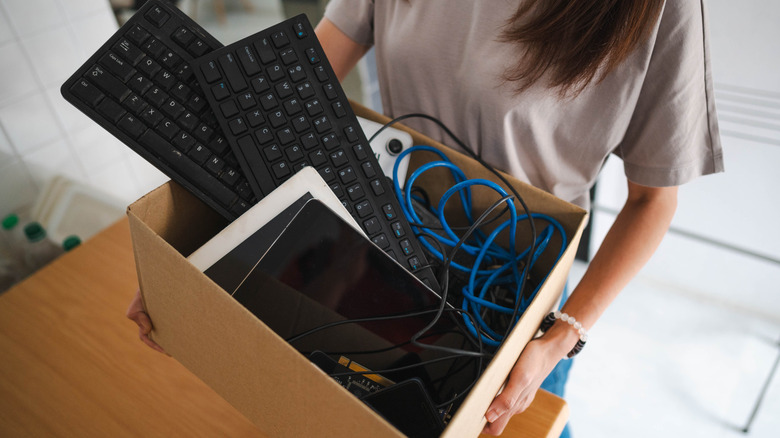11 Ways Make Your Home Decluttering Process More Environmentally-Friendly
Decluttering your home can be a transformative experience, both for your living space and for your mental and physical well-being. However, this process can also generate a significant amount of waste, which can be detrimental to the environment. Thankfully, there are ways you can adopt environmentally friendly decluttering methods that help you minimize your carbon footprint while creating a more organized and serene home. With this approach, you can feel good about how you're decluttering your home. You might initially feel overwhelmed at the thought of making your decluttering process eco-friendly, assuming it requires extra effort or resources. However, the truth is that it's easier than you'd think. Simple changes in how you sort, dispose of, and repurpose items can make a substantial difference.
The benefits of an environmentally-friendly approach to decluttering and organizing your home are manifold. It reduces the amount of waste that ends up in landfills, thereby decreasing pollution and conserving natural resources. It also encourages the reuse and recycling of items, which can discourage the purchase and production of unnecessary goods. Additionally, donating usable items to charities or thrift stores supports those in need and extends the life cycle of products.
An eco-friendly decluttering process can further inspire mindfulness and intentionality in your consumption habits. It can encourage you to think critically about your purchases and their long-term impact on the environment. This mindset shift can lead to more productive living habits overall, fostering a healthier relationship with your possessions and the planet. The following 11 methods are practical, accessible, and effective to help guarantee that your journey to a clutter-free home is as rewarding as possible.
Donate used items
Allowing someone else the opportunity to use what you no longer want through donating items helps to extend their lifecycle. It keeps usable goods out of landfills and can support local community organizations that redistribute items to those in need. Do a room-by-room sweep and set aside items you no longer need but that are still in good condition. Then, identify local charities, thrift stores, or shelters that accept donations and set up a time to drop off your items. Many of these organizations even offer pick-up services, making it convenient to donate larger items.
Recycle your electronics
Recycling your electronics can prevent hazardous materials from polluting the environment and allows valuable components, like metals, to be reused. This reduces the demand for new raw materials and minimizes electronic waste. Many cities have e-waste recycling programs or designated drop-off points for electronics. Some retailers may also offer recycling service for old gadgets, making it easy to dispose of them responsibly. Begin by gathering up all your outdated or broken electronics in your home and wiping any personal data off these devices. Then, take them to the nearest e-waste recycling option near you.
Compost organic waste
Composting reduces the amount of organic waste in landfills, decreasing emissions and creating nutrient-rich soil for your garden. By breaking down your items, you can turn plant waste into rich organic material. Therefore, if you have some non-glossy, uncolored paper, cardboard without glue, or even natural fabric items, you can put these in your compost pile with food scraps to reuse them. Make your own DIY compost in the backyard in a bin or through community composting programs as a simple way to turn your scraps into a useful resource.
Repurpose and transform
You might consider repurposing and giving new life to old items, perhaps reducing the need for new resources. This creative approach can help conserve materials and energy while also keeping items out of the landfill. It can also save you money, since you may be able to make something instead of purchasing an item new. Get creative with DIY projects that transform old furniture, clothing, or household items into something new and useful. Identify a few things in your donation box that you could repurpose and start with simple projects to build your confidence and skills.
Reuse items
Reusing the items you already have at home that you might otherwise throw away is not only a powerful and resourceful way to reduce waste, but a great way to keep your home organized and reduce clutter. You can turn your glass jars into a drinking cup or storage container for leftovers, or you could use your old newspapers as wrapping paper or cat box liners. This mindset demonstrates how small changes can make a big difference. Look around your home for items like your plastic containers, jars, and boxes, and develop creative ways to reuse them.
Host a swap party
Know other people who are decluttering their homes, too? Consider hosting a swap party to encourage the exchange of items, promoting reuse and extending the life cycle of pieces you don't want anymore. With this approach, you can declutter by getting rid of things you don't want and swap them for something you can use. This helps decrease waste and supports a circular economy. Plan a date and invite your friends and neighbors. Set up a space for displaying items and establish simple rules for swapping. This social event can make decluttering fun and collaborative.
Sell items you don't want
The old adage "one man's trash is another man's treasure" still holds true when it comes to decluttering your home. Selling items can extend their life cycle and reduce waste while also helping you make a little cash. Sort through your belongings and determine what's in good condition that you no longer need. Use online platforms to list these items, or set up a garage or yard sale to sell locally. Selling items you don't need will not only free up space in your home, but also encourage mindfulness about what you keep and let go of.
Utilize paper free options and organization
Going digital can minimize paper waste and the resources and energy needed to produce those products. Print subscriptions can easily pile up, so eliminating them makes it much easier to organize and maintain a tidy space. Upcycle or repurpose old newspapers and magazines, then cancel your physical subscriptions and use cloud storage and digital subscriptions instead. You should still hold on to physical copies of important documents like birth certificates and tax forms, but you can scan and upload basically everything else of note to help reduce your clutter.
Utilize various eco-friendly services like Trashie
There are various services out there that promote reducing household waste. Trashie, for example, is a service that specializes in recycling or repurposing old clothes, ensuring they are given new life rather than contributing to landfill waste. This service supports decluttering by providing an easy and eco-friendly way to dispose of your old, unwanted clothing. The process is straightforward — just fill your bag with washed clothes and drop it off at the post office. Trashie will handle the rest, making it easy to declutter your wardrobe sustainably.
Post on your local Buy Nothing Facebook group
If you can find a local Buy Nothing Facebook group, then you have a perfect opportunity to give items you no longer need away to community members. By offloading items through a Buy Nothing group, you can declutter your space while ensuring that your perfectly usable goods find new homes instead of ending up in landfills. This practice not only supports a circular economy, but fosters a sense of community and collective responsibility to the environment. Simply take pictures of the things you don't want and post to see if anyone would like to claim them.
Implement a one in, one out rule
A one in, one out rule helps maintain a clutter-free home and can encourage mindful consumption. It also can promote a balanced approach to acquiring and discarding items. Instead of making a purchase without thinking, donate or sell one item for every new item you bring in to prevent clutter buildup. This rule can help you maintain a tidy and organized space and will reduce the amount of items that enter your home. By helping to cut down impulse purchases, this method can ensure you're not stuck having to go through the deluttering process again in a few months.











